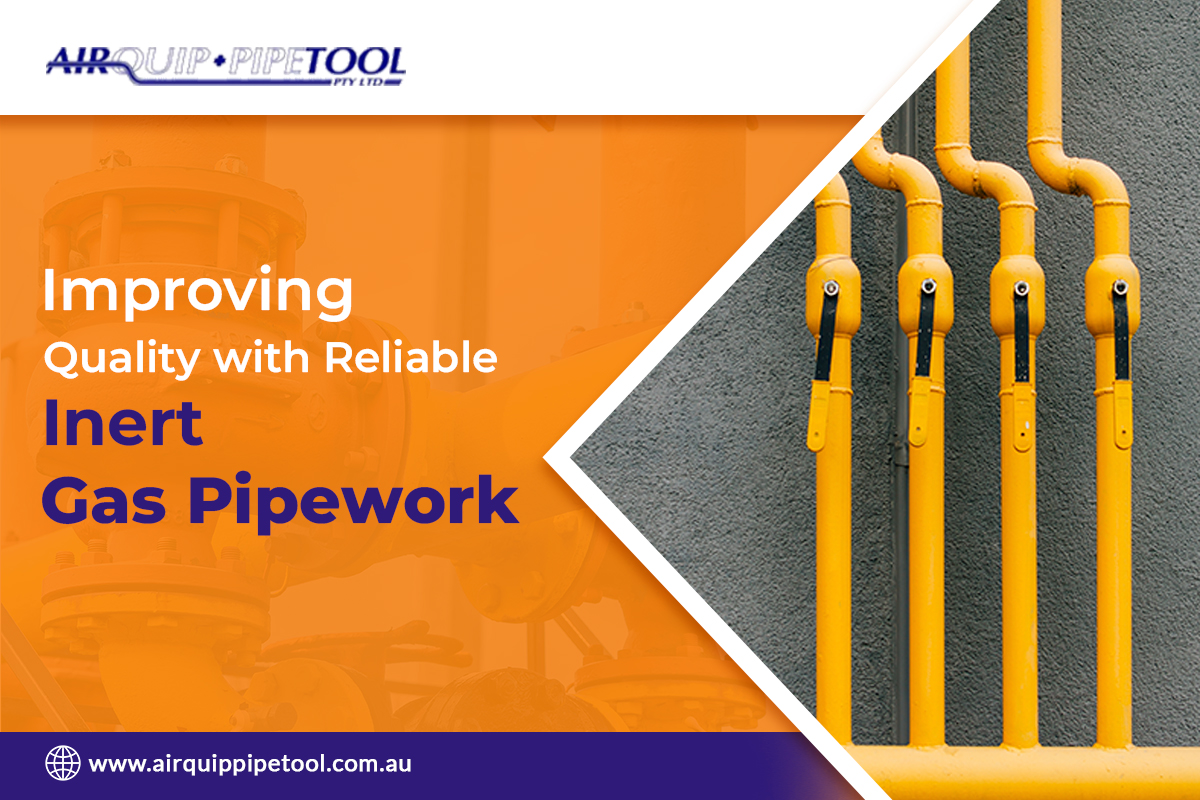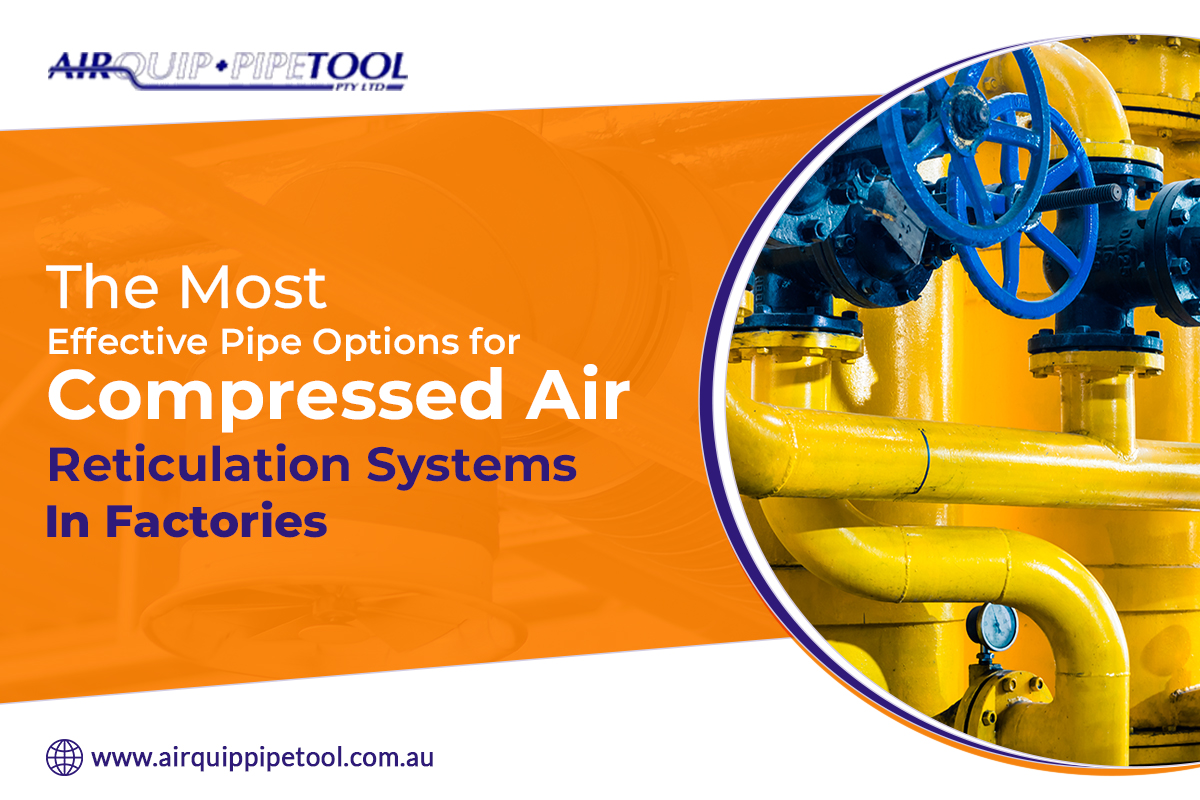-
by airquippipetool
-
News
-
.
17 Jan 2025
The Most Effective Pipe Options for Compressed Air Reticulation Systems in Factories
A well-designed compressed air reticulation system is the backbone of any industrial operation, especially in factories. The choice of pipe options has a direct impact on the overall performance of the system, affecting everything from air quality to pressure consistency. By choosing the right pipes, you can enhance the reliability and efficiency of your compressed air reticulation system, reducing costs and increasing output. In this blog, we’ll examine the best pipe choices for your factory’s compressed air needs, helping you make an informed decision for optimal results.
Important Aspects to Keep in Mind When Choosing Pipes for Compressed Air Reticulation Systems
Here are some important aspects to consider when choosing pipes for compressed air reticulation systems:
- Pipe Material: Choose corrosion-resistant materials like stainless steel or aluminium to ensure long-term durability and minimal maintenance for your compressed air reticulation system.
- Pipe Size: Ensure pipes are correctly sized to prevent pressure drops and maintain consistent airflow, optimising system efficiency.
- Pressure Rating: Select pipes with a suitable pressure rating to withstand the maximum operating pressure, preventing failures and safety hazards.
- Maintenance and Durability: Opt for materials that require less frequent maintenance, reducing downtime and extending the life of the compressed air reticulation system.
The Ideal Pipe Materials For Compressed Air Reticulation Systems
1. Stainless Steel
Stainless steel is a highly durable material commonly used for compressed air piping systems. Known for its strength and corrosion resistance, stainless steel is ideal for environments that require a clean, robust, and long-lasting solution.
Advantages:
- Exceptional Durability: Stainless steel is incredibly resistant to corrosion, rust, and wear, ensuring long-term performance and minimal maintenance.
- Strength: It can withstand high pressures and harsh conditions, making it suitable for demanding compressed air applications.
- Hygienic: The smooth, non-porous surface of stainless steel prevents bacterial growth, maintaining air quality and cleanliness.
- Aesthetic Appeal: Its sleek, shiny finish offers a modern and professional appearance, which is especially important in industries where aesthetics matter.
Disadvantages:
- High Cost: Stainless steel is generally more expensive than other materials like plastic or polyethylene, making it a higher initial investment.
- Rigid: Unlike flexible materials, stainless steel is less adaptable and can be more challenging to install in tight or complicated spaces.
2. Aluminium
Aluminium is a lightweight, corrosion-resistant material often used in compressed air systems. Known for its smooth internal surface, aluminium helps maintain air quality and ensures the system remains efficient over time.
Advantages:
- Corrosion-Resistant: Aluminium naturally resists corrosion, making it a durable option in humid or outdoor environments.
- Lightweight: Being lighter than steel, aluminium is easier to handle and install, reducing overall labour costs.
- Maintains Air Quality: The smooth interior surface helps prevent the build-up of dirt and contaminants, ensuring clean air flow throughout the system.
- Durable: Aluminium systems offer a long lifespan with minimal maintenance, providing excellent reliability for compressed air applications.
Disadvantages:
- Susceptible to Physical Damage: Although corrosion-resistant, aluminium is softer and can be more prone to dents and damage compared to harder metals like stainless steel.
- Higher Cost: Aluminium tends to be more expensive than plastic options like nylon, though it is still more affordable than stainless steel.
3. HDPE Piping
HDPE (High-Density Polyethylene) piping is a versatile, durable material commonly used for compressed air systems. Known for its flexibility and resistance to various environmental factors, HDPE is an excellent choice for applications requiring low maintenance and long-lasting performance. It offers three primary coupling options: Compression, Socket-Fusion (welded), and Electro-Fusion (welded), each providing reliable connections.
Advantages:
- Durability: HDPE is highly resistant to wear, corrosion, and chemicals, ensuring longevity in demanding environments.
- Flexible: It can bend around corners and obstacles, making installation easier in complex layouts or tight spaces.
- Low Maintenance: HDPE piping requires minimal upkeep, reducing downtime and costs over time.
- Corrosion-Resistant: Unlike metal pipes, HDPE is immune to rust and corrosion, making it ideal for environments with moisture or harsh chemicals.
- Variety of Coupling Options: With options like Compression, Socket-Fusion, and Electro-Fusion, HDPE pipes offer versatile and secure jointing methods for different system needs.
Disadvantages:
- Installation Expertise: Socket-Fusion and Electro-Fusion methods require skilled personnel and specialised equipment, adding to initial installation complexity.
- Temperature Limitations: HDPE may not perform as well in extremely high-temperature environments compared to metals like stainless steel or aluminium.
4. KWIKfit
KWIKfit is a semi-rigid nylon pipe system designed for easy installation of compressed air systems. Its flexibility, ease of use, and reusable fittings make it a popular choice for both industrial workshops and home garages.
Advantages:
- Ease of Installation: KWIKfit is designed for quick and straightforward installation, reducing both time and labour costs.
- Reusable Fittings: The system’s fittings can be reused, which helps reduce ongoing maintenance and replacement costs.
- Expandable: The system can be easily modified or expanded, making it ideal for growing or changing compressed air needs.
- Cost-Effective: Due to the easy installation and reusability of parts, KWIKfit offers a cost-effective solution for many users.
Disadvantages:
- Not UV Stable: KWIKfit is not designed for installation in direct sunlight, as prolonged UV exposure can degrade the nylon material, leading to reduced performance and durability.
- Temperature Sensitivity: The system may not perform optimally in environments with extreme temperature fluctuations, limiting its use in outdoor or unregulated settings.
Conclusion
In conclusion, choosing the right materials for your compressed air reticulation system is essential for ensuring both performance and longevity. Whether you prefer the ease of installation of KWIKfit, the robustness of stainless steel, the flexibility of HDPE, or the corrosion resistance of aluminium, it is important to rely on professional pipework installation services for a reliable setup.
Airquip and Pipetool Pty Ltd specialises in providing expert advice and high-quality installation services tailored to your specific needs. With reliable solutions and seamless service, you can trust us to meet all your compressed air system requirements with precision and care.
 " alt="">
" alt="">
 " alt="">
" alt="">
 " alt="">
" alt="">


